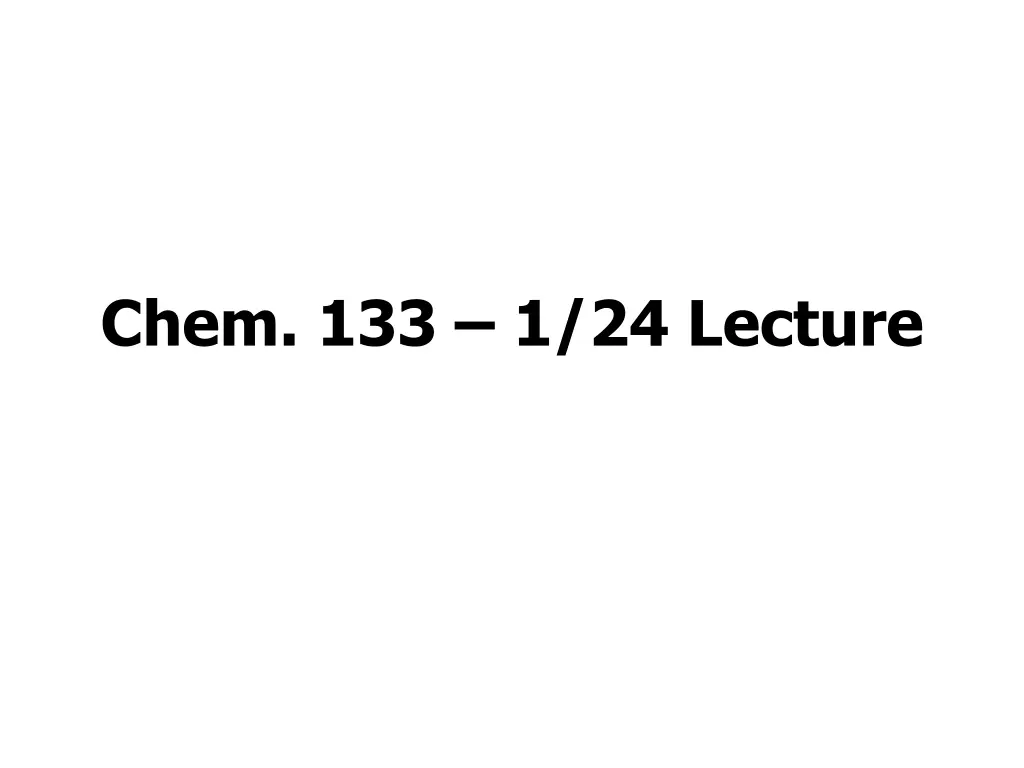
Chemical Instrumentation - Course Overview and Student Enrollment Details
Dive into the world of Chemical Instrumentation with this course overview covering learning objectives, student enrollment process, and class details. Explore the essential skills and knowledge sets for instrument operation, performance evaluation, and applications in chemical analysis. Understand the priorities for adding students based on prerequisites, majors, and graduation dates. Access syllabus, handouts, and textbooks to kickstart your journey in analytical chemistry.
Download Presentation

Please find below an Image/Link to download the presentation.
The content on the website is provided AS IS for your information and personal use only. It may not be sold, licensed, or shared on other websites without obtaining consent from the author. If you encounter any issues during the download, it is possible that the publisher has removed the file from their server.
You are allowed to download the files provided on this website for personal or commercial use, subject to the condition that they are used lawfully. All files are the property of their respective owners.
The content on the website is provided AS IS for your information and personal use only. It may not be sold, licensed, or shared on other websites without obtaining consent from the author.
E N D
Presentation Transcript
Introduction Instructors: Roy Dixon (lecture) Justin Miller-Schulze (lab)
Class: Chemical Instrumentation General Goals of Education (copied roughly from Dean several years ago): Jobs Career Skills Knowledge Member of Society Future Life-long Learner Main focus will be on skills and knowledge, but sometimes it is worth looking at larger picture
Learning Objectives of Class (Skills and Knowledge Set) Learn how instruments work Learn measures of instrument performance and what affects performance Know common applications of instruments (e.g. how can we use an instrument to determine a compound s concentration, identity or structure) Connect instrument performance with method/sample/analyte demands
Roll Call and Adding Students Class normally has 12 students Currently 6 in class and 14 on waitlist We will add 6 from waitlist Demand is such that we would like to add a class F17 (but this can t be guaranteed) Adding students will be based on priority
Adding Students cont. Priority for Adding Students 1. Students must have prerequisites 2. BS Chem majors graduating S 17 3. BS Chem majors graduating F 17 and non-BS Chem majors graduating S 17* and needing class (equal) 4. Others graduating F 17 *Will try to find alternatives to this class to keep grad date from being post-poned Within each category, preference given to those higher on waitlist and for those on past waitlists You may be asked to show evidence for your graduation date (I m going off petitions to graduate)
Handouts Syllabus Homework Assignment 1.1
Syllabus Top 3 Items Lab Class room = Sequoia 516, but will spend time in other instrument rooms too Office hours can arrange meetings at other times Internet Site Site listed is for lecture except grading and quiz keys SacCT (sec 1 and sec 2 sites) for keys, grading, and lab handouts
Syllabus Text Books Harris (Quantitative Chemical Analysis) Main text We are using the 8thEdition (note: Chem 31 is now using 9th Edition) Rubinson and Rubinson (Contemporary Instrumental Analysis) Supplementary text book Copy placed in main office Used for electronics and NMR instruction Skoog et al. (Principles of Instrumental Analysis) Recommended for anyone interested in working as an analytical chemist
Grading Lecture Component Exams (44% of grade) 2 midterms (see syllabus for dates) Comprehensive Final Exam Quizzes (7% of grade) Roughly every 2 weeks unless near exam First will be next Thursday Homework (4% of grade) Only a subset of problems will be turned in (Bold problems in first set)
Grading Lab Component Details explained by lab instructor Lab Reports/Lab Practical (35% of grade) Term Project (10% of grade)
Topics Electronics Emphasis on understanding multiple aspects of electronics for instruments Some topics will be covered qualitatively Electrochemistry (fundamentals + qualitative understanding of ion selective electrodes) Spectroscopy Fundamental sections (theory and spectrometer components) Specific types (UV-Visible, fluorescence, atomic, and NMR) Mass Spectrometry Chromatography Theory of separations, and main components GC and HPLC
Homework Set 1 Three subsets (1.1, 1.2, and 1.3) Only Subset 1.1 is currently available (others will soon be posted online) Bold Homework problems are graded; do not turn in other problems Subsets should be done before quizzes Solutions will be posted.
Todays Lecture Measures of Instrument Performance Overview of Electronics Electronic Definitions and Basic Laws
In Lab Today Data/Excel Basics covering here Lab Safety
Measures of Instrument or Method Performance What is he talking about? Example: method accuracy Get class to come up with 7+ measures
Electronics Topics Covering Basic DC Circuits (Ohm s Law, Power Law, Kirchhoff s Laws + applications) Alternating Currents, Other Waveforms, and Fourier Transformation (lecture only) RC Circuits Diodes (lecture only) Signal Digitization (lecture only) Transducers (lecture only) Noise
Electronics - Overview Generic Instrument Block Diagram Analog Electronics Analog Signal Processing Transducer sample Exciter Digital to Analog (control) Analog to Digital Conversion Board Digital Electronics Long-term Storage (Disk) Digital Signal Processing Signal Display Memory
Electronics Example Block Diagram for an Atomic Emission Spectrometer From: David Zellmer, CSU Fresno http://zimmer.csufresno.edu/~davidz/Chem106/ModZoo/ModZoo.html
Electronics Go to Board to Cover: Definitions, Ohm s Law, and Power Law
